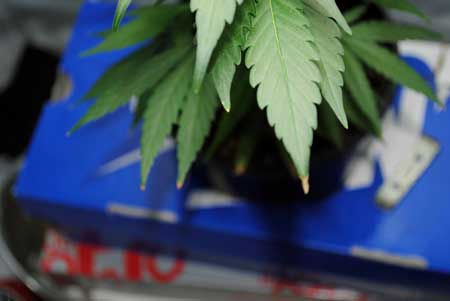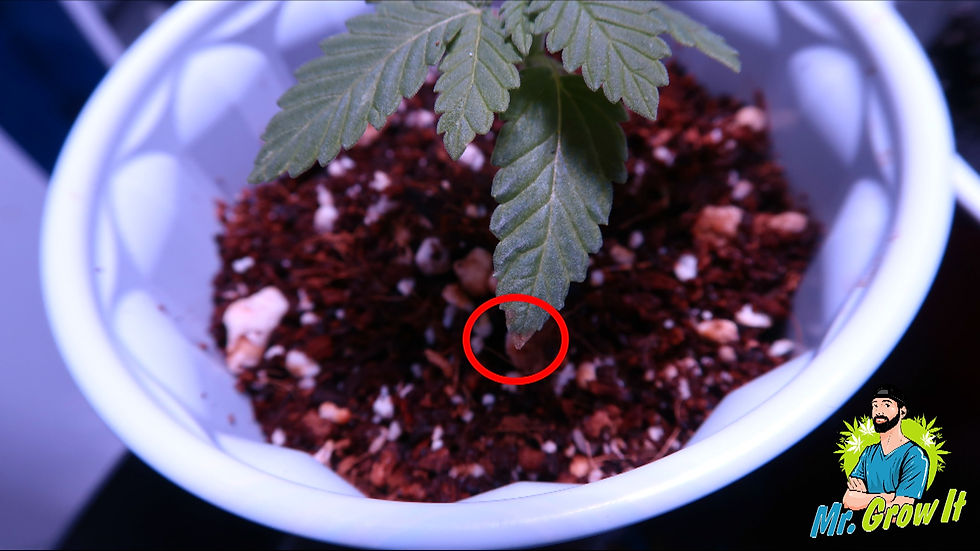Nutrient Burn on Cannabis Plants!
- Mr. Grow It

- Mar 29, 2022
- 4 min read

Many cannabis growers, particularly those who recently started, may be surprised to discover that their cannabis plants have nutrient burn and that it is caused by an abundance of nutrients instead of not enough nutrients. Since nutrient burn can cause damage to cannabis plants, it is just as important to fix this problem as it is to fix a nutrient deficiency. This article will not only help you diagnose nutrient burn but will also provide you with tips and tricks to treat it.
What is a Nutrient Burn?
Nutrient burn, also called “nute burn”, is a condition that occurs when the cannabis plants have an overabundance or excess of nutrients. Since plants do not have a mechanism to control the intake of nutrients like nitrogen, they absorb what is provided or fed to them. New growers commonly face this problem as they tend to think that providing bottles nutrients will help with plant growth. Although providing bottled nutrients in excess can be the cause of the nutrient burn, it is not the only cause. For novice growers, the key to avoiding the issue is to understand that more is not necessarily better.

Cause of Nutrient Burn
Nutrient burn is caused by an abundance of nutrients, but adding high levels of chemical and mineral-based nutrients is not the sole cause of it. Here are a few other circumstances that can lead to nutrient burn:
Seedlings in “hot” soil: When seedlings are put in a growing medium or “hot soil” with manure or compost, they tend to get nutrient burn because the medium contains more nutrients than the seedlings need.
Excessive Use of Growth Stimulators: Using growth hormones frequently may cause dwarfism in cannabis plants which will, in turn, lead to nutrient burn
In most cases, the cause is feeding bottles of nutrients in excess. Even though these mineral-based nutrients help plants grow faster and increase the yield, they are also more likely to cause nutrient burn in cannabis plants. This is the reason that using organic-based nutrients and growing in organic soil alleviates the chances of this issue from occurring.
Symptoms of Nutrient Burn
Nutrient burn can be diagnosed using the symptoms listed in the bullet points below:
Before any burn, you may notice signs of nutrient buildup which include bright and dark green leaves, leaves pointing straight up, and red or magenta branches.
Brown, yellow, or bronze tips of the leaves are a tell-tale sign of nutrient burn. One way to distinguish it from potassium deficiency is to carefully look at the margins or edges of leaves. If you see a lot of yellowing of margins along with some interveinal chlorosis, then there is a chance that your plant is suffering from potassium deficiency.
Curling or clawing of the leaves tips is another sign of nutrient burn
Tips becoming bronze and crispy
Leaves dying and falling off

If you observe that most of the above symptoms are present upon monitoring your cannabis plants, it is important that you start treatment immediately. Some growers may think that nutrient burn is a good indicator and will eventually lead to better yields - but that is wrong. Nutrient burn can negatively impact the buds and flowers; therefore, it is suggested to tackle the problem if it occurs. Besides affecting the plant growth and overall yield, some growers report untreated nutrient burn leaves the buds with an intense chemical smell - which is not desirable.
Fixing Nutrient Burn
To ensure that your cannabis plants stay healthy in both the vegetative and flowering stages, it is critical to fix nutrient burn. Here are a few steps that you can take:
If your plant is only showing damage at the tips of the leaves, you may be able to simply water the plant as needed for 1-2 weeks and see recovery. The damaged tips won't recover but new growth shouldn't have tip burn.
If you are growing in soil or coco coir and you see significant tip damage and/or multiple symptoms listed above, flush your system with pH balanced water. Do not add any nutrients and wait for your plants to use up the nutrients that are already present in the medium. Many growers use the runoff EC or PPM measurement to determine when to feed next.
If you are growing in a hydro system, you can either choose to change the water or dilute it by adding pH balanced water. If you choose to change the water completely, lower the nutrients to half of what you were using before. Do not make any big, abrupt changes as this step is sufficient to bring nutrient burn to halt.
Using cannabis-friendly nutrients at the correct dosage and ratios will help avoid the problem altogether. When you decide to return to feeding, ensure that you do not overfeed again. Follow the appropriate nutrient ratios for flowering and vegetative stages. Make sure you follow the instructions or read the charts that come with nutrients to prevent the problem from reoccurring. Many growers will safe side it and do 1/2 or even a 1/4 of the recommended dosage listed on the feeding chart.
Using these treatment methods will eventually help your cannabis plants recover. Although the damage is not reversible, these steps will keep your plants from getting any further damage.
Prevention
As a novice grower, you may become overly enthusiastic and end up adopting the policy of more is better. But that is often not the case. It is better to feed accurately to avoid nutrient burn altogether in the future. Purchasing a TDS meter or EC meter to keep track of the nutrients in the system will help ensure you feed the proper amount. In the end, the goal is to keep the cannabis plant healthy to get an optimal yield. Using the provided tips will help ensure that you achieve this goal.
Sources:
CATEGORIES: Beginners Start Here







.png)


Yes. Great topic and great explanation. There is another cause of nutrient burn as well. Too much light. People call it light burn and they are correct in a way. Too much light leads the plants to go into high gear keeping up with photosynthesis and uptake more nutrients then they can handle. That exact pic u showed is the exact time I stop raising the dimmer on my light. Its called getting their nails done. U found their limit with causing minimul issues and u dial it back a hair. Too much DLI for the plant. Correct me if I am wrong. I heard guru discuss this on the dude grows show and it made total sense. Full disclosure…